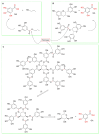The Potential Health Benefits of Gallic Acid: Therapeutic and Food Applications
- PMID: 39199245
- PMCID: PMC11352096
- DOI: 10.3390/antiox13081001
The Potential Health Benefits of Gallic Acid: Therapeutic and Food Applications
Abstract
Gallic acid (GA), a phenolic acid found in fruits and vegetables, has been consumed by humans for centuries. Its extensive health benefits, such as antimicrobial, antioxidant, anticancer, anti-inflammatory, and antiviral properties, have been well-documented. GA's potent antioxidant capabilities enable it to neutralize free radicals, reduce oxidative stress, and protect cells from damage. Additionally, GA exerts anti-inflammatory effects by inhibiting inflammatory cytokines and enzymes, making it a potential therapeutic agent for inflammatory diseases. It also demonstrates anticancer properties by inhibiting cancer cell growth and promoting apoptosis. Furthermore, GA offers cardiovascular benefits, such as lowering blood pressure, decreasing cholesterol, and enhancing endothelial function, which may aid in the prevention and management of cardiovascular diseases. This review covers the chemical structure, sources, identification and quantification methods, and biological and therapeutic properties of GA, along with its applications in food. As research progresses, the future for GA appears promising, with potential uses in functional foods, pharmaceuticals, and nutraceuticals aimed at improving overall health and preventing disease. However, ongoing research and innovation are necessary to fully understand its functional benefits, address current challenges, and establish GA as a mainstay in therapeutic and nutritional interventions.
Keywords: anticancer activity; antioxidant; human health; pharmaceutical applications; phenolic compounds.
Conflict of interest statement
The authors declare no conflict of interest.
Figures




References
-
- Rahman M.M., Rahaman M.S., Islam M.R., Rahman F., Mithi F.M., Alqahtani T., Almikhlafi M.A., Alghamdi S.Q., Alruwaili A.S., Hossain M.S., et al. Role of Phenolic Compounds in Human Disease: Current Knowledge and Future Prospects. Molecules. 2021;27:233. doi: 10.3390/molecules27010233. - DOI - PMC - PubMed
-
- McClements D.J. Future Foods: Is It Possible to Design a Healthier and More Sustainable Food Supply? Nutr. Bull. 2020;45:341–354. doi: 10.1111/nbu.12457. - DOI
-
- Haghani S., Hadidi M., Pouramin S., Adinepour F., Hasiri Z., Moreno A., Munekata P.E.S., Lorenzo J.M. Application of Cornelian Cherry (Cornus mas L.) Peel in Probiotic Ice Cream: Functionality and Viability during Storage. Antioxidants. 2021;10:1777. doi: 10.3390/antiox10111777. - DOI - PMC - PubMed
-
- Gueffai A., Gonzalez-Serrano D.J., Christodoulou M.C., Orellana-Palacios J.C., Ortega M.L.S., Ouldmoumna A., Kiari F.Z., Ioannou G.D., Kapnissi-Christodoulou C.P., Moreno A., et al. Phenolics from Defatted Black Cumin Seeds (Nigella sativa L.): Ultrasound-Assisted Extraction Optimization, Comparison, and Antioxidant Activity. Biomolecules. 2022;12:1311. doi: 10.3390/biom12091311. - DOI - PMC - PubMed
-
- Martins N., Barros L., Ferreira I.C.F.R. In Vivo Antioxidant Activity of Phenolic Compounds: Facts and Gaps. Trends Food Sci. Technol. 2016;48:1–12. doi: 10.1016/j.tifs.2015.11.008. - DOI
Publication types
LinkOut - more resources
Full Text Sources
Research Materials

